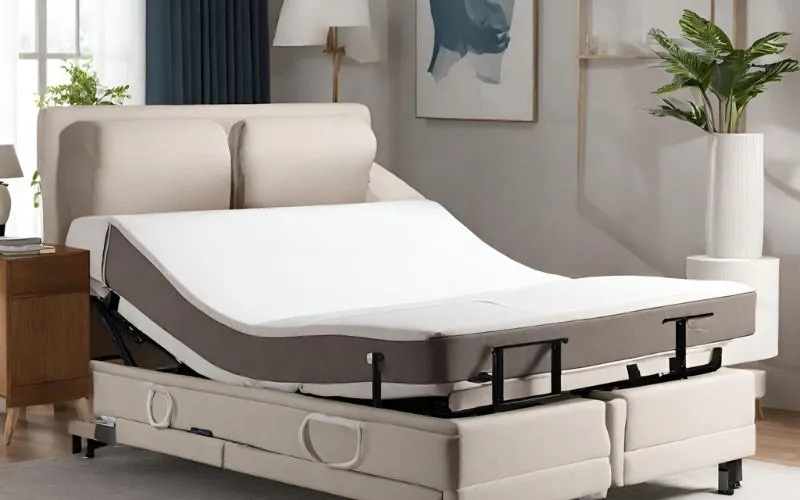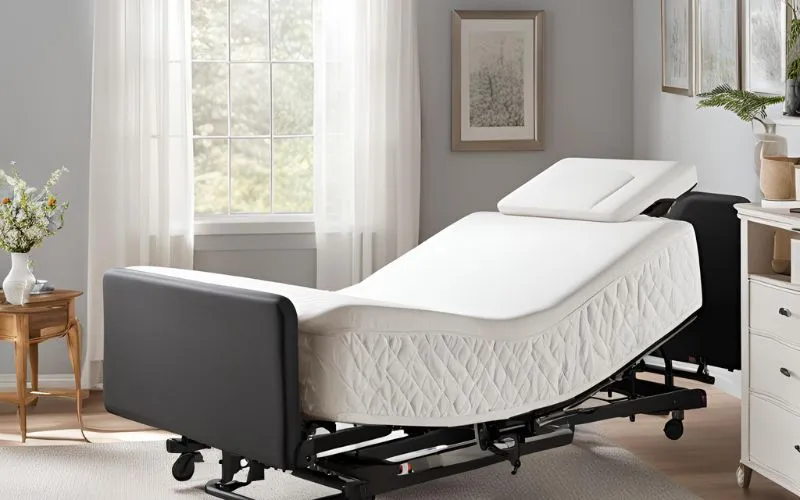Adjustable Bed Health Benefits: A Complete Guide

Introduction
Adjustable beds are becoming increasingly popular due to their ability to provide personalized comfort and support. They are designed to offer a range of positions, which can alleviate various health issues, improve sleep quality, and enhance overall well-being. In this article, we will explore the health benefits of adjustable beds, factors to consider when choosing one, and tips for using them safely.
What are Adjustable Beds?
Definition and Function
Adjustable beds, also known as power beds or reclining beds, are specially designed to provide enhanced support and comfort. They consist of a multi-hinged surface that can be adjusted to different inclinations, allowing users to find the most suitable sleeping or resting position. These beds are controlled electronically through a remote, enabling individuals to elevate their head, feet, or both, as per their preference.
- Health Benefits: Adjustable beds are known for offering various health benefits, such as improving blood circulation, aiding in digestion, reducing snoring, and relieving back pain.
- Customization: Users can personalize their sleeping experience by adjusting the angles and positions of the bed, providing optimum comfort for different activities like reading or watching TV.
- Therapeutic Support: These beds are often recommended for individuals with medical conditions such as sleep apnea, acid reflux, and edema, as they can help alleviate symptoms and improve overall well-being.
- Technological Advancements: Modern adjustable beds come equipped with advanced features like massage functions, USB ports, under-bed lighting, and memory settings, enhancing the overall user experience.
Adjustable Bed Features
Modern adjustable beds come with a range of features that cater to various needs and preferences. These include:
- Massage Settings: Adjustable beds are equipped with soothing massage functionalities that target specific areas of the body to alleviate tension and promote relaxation. The varying intensity levels allow users to customize their massage experience based on their individual comfort levels.
- USB Ports: The built-in USB ports offer convenient charging capabilities for electronic devices, allowing users to keep their phones, tablets, or other devices within reach while resting or sleeping.
- Under-Bed Lighting: The ambient under-bed lighting enhances accessibility during nighttime hours, providing a gentle source of illumination while minimizing disturbance to sleeping partners.
- Programmable Memory Positions: Users can store their preferred settings for optimal comfort and support, allowing for seamless adjustment to their favored sleeping and resting positions with the simple press of a button.
Health Benefits of Adjustable Beds
Improvement in Sleep Quality
Adjustable beds play a significant role in enhancing the quality of sleep by offering personalized comfort and support. These beds allow users to adjust their sleeping position, which can have numerous positive effects on sleep quality and overall well-being:
- Enhanced Comfort: By providing customizable support, adjustable beds help alleviate pressure points, improve circulation, and reduce tossing and turning during sleep.
- Optimized Breathing: Elevating the head and upper body can open up airways, minimize snoring, and improve breathing patterns, particularly beneficial for individuals with sleep apnea, asthma, or congestion.
- Acid Reflux Relief: Inclining the upper body can prevent stomach acid from entering the esophagus, reducing the discomfort associated with acid reflux and heartburn.
- Alleviation of Sleep Apnea: Adjusting the bed to elevate the head and torso can help keep the airway open, supporting continuous, uninterrupted breathing for individuals with sleep apnea.
Furthermore, the ability to customize the sleep position to an individual’s preference promotes relaxation and stress reduction, contributing to a more restful and rejuvenating sleep experience.
Relief for Various Health Conditions
Adjustable beds offer relief for a wide range of health conditions, providing comfort and support for individuals dealing with:
- Arthritis
- Back pain
- Swelling
These conditions can significantly impact daily life, but the versatility of adjustable beds can make a noticeable difference. Here’s how:
- Pressure Reduction: Adjustable beds can elevate specific areas to reduce pressure on affected body parts, offering relief and comfort for individuals with arthritis, back pain, and swelling.
- Spinal Alignment: By promoting proper spinal alignment, adjustable beds can alleviate discomfort and improve overall well-being for those dealing with these health conditions.
- Muscle Tension: The varied positions of adjustable beds can provide relief from muscle tension, contributing to improved comfort and mobility.
- Circulation: Improved circulation is essential for managing health conditions like arthritis, back pain, and swelling. The adjustable positions of the bed can enhance circulation, promoting better overall health and well-being.
Factors to Consider When Choosing an Adjustable Bed
Mattress Type and Material
When it comes to choosing a mattress for an adjustable bed, several factors need to be considered. The type and material of the mattress play a crucial role in determining comfort, support, and overall satisfaction. Let’s delve deeper into the various mattress types and materials that are well-suited for adjustable beds:
- Memory Foam Mattresses: These mattresses are renowned for their ability to contour to the body’s shape, providing exceptional support and pressure relief. The adaptability of memory foam makes it an excellent choice for adjustable beds, as it can easily adjust to different positions without losing its supportive properties.
- Latex Mattresses: Known for their resilience and durability, latex mattresses offer a responsive and supportive sleep surface. They are naturally breathable, which helps in regulating body temperature, making them an ideal choice for adjustable beds.
- Innerspring Mattresses: While traditionally associated with standard bed frames, some innerspring mattresses are designed with flexible materials that make them compatible with adjustable bed bases. These mattresses provide a good balance of support and comfort, catering to a wide range of sleep preferences.
- Hybrid Mattresses: Combining the features of both memory foam and innerspring mattresses, hybrid mattresses offer the best of both worlds. With a hybrid mattress, you can experience the contouring benefits of memory foam along with the sturdy support of innerspring coils, making it an excellent choice for adjustable beds.
- Gel-Infused Mattresses: Gel-infused mattresses are designed to provide enhanced cooling properties, which can be beneficial for those who tend to sleep hot. The gel-infused layers help dissipate body heat, contributing to a more comfortable and temperature-neutral sleep environment on adjustable bed surfaces.
When evaluating the material of the mattress, it’s essential to prioritize durability and resilience. The chosen material should withstand the frequent adjustments and movements associated with adjustable beds, ensuring long-term performance and comfort.
Sturdiness and Durability
Sturdiness and Durability
- High-Quality Materials: An adjustable bed frame’s sturdiness and durability are dependent on the materials used in its construction. Look for frames made from robust steel or durable wood, ensuring longevity and reliability.
- Structural Design: The overall design and structure of the adjustable bed frame contribute to its sturdiness. Features like reinforced joints, sturdy support bars, and a solid base enhance the frame’s stability and durability.
- Weight Capacity Considerations: Adequate weight capacity is crucial for maintaining the bed’s sturdiness and preventing any structural damage. Choose a frame with a weight capacity that accommodates the intended users without compromising stability.
- Motor Reliability: Smooth operation and longevity of an adjustable bed are tied to the reliability of its motors. Opt for models equipped with high-quality, dependable motors to ensure consistent and trouble-free adjustments.
Tips for Using Adjustable Beds Safely
Operating the Adjustable Bed Controls
Adjustable beds come with a variety of controls that allow users to customize their sleeping positions for comfort and support. Understanding how to operate these controls is essential for maximizing the benefits of an adjustable bed. The following details provide a comprehensive guide to operating the adjustable bed controls:
- Hand Control: The hand control is the primary interface for adjusting the position of the bed. It typically features buttons or dials for raising or lowering the head and foot sections, as well as adjusting the overall height of the bed. Some advanced models may also offer options for lumbar support and massage settings.
- Range of Motion: Different adjustable beds offer varying degrees of motion adjustments. Users should familiarize themselves with the full range of motion available, ensuring that they can find the most comfortable sleeping positions.
- Speed Settings: Some adjustable beds include speed settings for adjusting the position of the bed. High-speed settings may be useful for quickly finding the desired position, while low-speed settings can provide a more gradual and controlled adjustment for added precision.
- Weight Limits: It’s crucial to adhere to the weight limits specified by the manufacturer to maintain the structural integrity of the bed. Exceeding these limits could lead to malfunctions and potential safety hazards.
In addition to the basic controls, it’s important to heed the following considerations when operating an adjustable bed:
- Consult the Manufacturer’s Instructions: Always refer to the manufacturer’s instructions and user manual for specific guidance on operating the adjustable bed controls. Following these instructions can help prevent misuse and prolong the lifespan of the bed.
- Health Consultation: Individuals with specific health concerns, such as back pain, sleep apnea, or circulation issues, should seek advice from their healthcare provider before using an adjustable bed. Understanding how to optimize the bed’s settings to address these concerns can lead to better sleep quality and overall well-being.
Maintenance and Care
Regular maintenance and care are crucial for ensuring the longevity and optimal performance of adjustable beds. This includes cleaning the bed frame, lubricating the moving components, and inspecting the electrical connections. Additionally, individuals should follow the manufacturer’s guidelines for replacing worn-out parts and addressing any technical issues promptly.
- Cleaning: Wipe down the bed frame and all movable parts with a damp cloth and a mild detergent to remove any dust, debris, or residue. Pay special attention to areas where moving components meet the frame.
- Lubrication: Use a silicone-based lubricant to grease the moving components of the bed, such as the joints, hinges, and mechanisms. This helps to prevent friction, reduce wear and tear, and ensure smooth operation.
- Electrical Connections: Inspect the electrical connections regularly to ensure they are secure and free from damage. If there are any signs of wear or damage, consult a professional to address the issue promptly.
- Manufacturer’s Guidelines: Adhere to the manufacturer’s recommendations for the replacement of worn-out parts and the resolution of technical issues. This may involve contacting authorized service providers or following specific procedures outlined in the user manual.
Conclusion
Adjustable beds offer a host of health benefits and can significantly enhance the quality of sleep and daily comfort. Understanding the features and factors to consider when choosing an adjustable bed, along with using it safely, can contribute to improved well-being and restful sleep. By prioritizing the suitability and proper use of adjustable beds, individuals can experience positive changes in their overall health and lifestyle.




